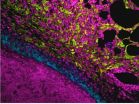A possible answer for protection against chemical/biological agents, fuel leaks, and coffee stains
A recent discovery funded by the Air Force Office of Scientific Research may very well lead to a process that not only benefits every uniformed service member of the Department of Defense, but everyone else as well
2013-01-31
(Press-News.org) A recent discovery funded by the Air Force Office of Scientific Research (AFOSR) may very well lead to a process that not only benefits every uniformed service member of the Department of Defense, but everyone else as well: protection from Chemical/Biological agents, to self-cleaning apparel, to effortless thermal management, to fuel purification as well as enhanced control of leaks—especially oil and fuels.
In 2006, AFOSR Program Manager Dr. Charles Lee funded Professor Gareth McKinley at the Massachusetts Institute of Technology exploring nanocomposite technology for Defense applications. Anish Tuteja, an MIT doctoral student at the time, was exploiting the unusual surface properties of a nanocomposite with fluorinated nanoparticles, to create a superoleophobic surface. After graduation, Tuteja moved to University of Michigan in Ann Arbor, where he is currently an assistant professor of materials science and engineering, specializing in chemical engineering and macromolecular science and engineering. He was awarded a Young Investigator Program grant from AFOSR in 2011, and continued to conduct the same line of research begun at MIT. His team also included doctoral student Shuaijun Pan and postdoctoral researcher Arun Kota, as well as collaboration with Dr. Joseph Mabry, from the Rocket Propulsion Division of the Air Force Research Laboratory, at Edwards AFB, California.
In their latest paper, "Superomniphobic Surfaces for Effective Chemical Shielding," in the current issue of the Journal of the American Chemical Society, Tuteja and his team have demonstrated surfaces that effectively perform as "chemical shields against virtually all liquids."
To make this possible, surfaces are prepared using a nanoscale coating that is approximately 95 percent air, which in turn, repels liquids of any material in its class, causing them to literally bounce off the treated surface. The surfaces "possess hierarchical scales of re-entrant texture that significantly reduce the solid−liquid contact area." It all comes down to controlling how much contact the liquid ultimately has with the treated surface. To accomplish that the researchers apply the nanoscale coating using a process called electrospinning—using an electric charge to create fine particles of solid derived from a liquid solution.
The coating is a mixture of cross-linked "polydimethylsiloxane," or PDMS, and liquid-resisting nanoscale cubes developed by the Air Force that contain carbon, fluorine, silicon and oxygen. While the material's chemistry is important, so is its texture, because it hugs the pore structure of whatever surface it is applied to, and creates a fine web of air pockets within those pores, so any liquid that comes in contact with the coating is barely touching a solid surface.
According to Dr. Tuteja, when an untreated surface and a liquid get in close proximity, "they imbue a small positive or negative charge on each other, and as soon as the liquid comes in contact with the solid surface, it will start to spread….we've drastically reduced the interaction between the surface and the droplet." By effectively eliminating the contact between the treated surface and the liquid, there is almost no incentive for the liquid to spread, as such, the droplets stay intact, interacting only with molecules of themselves, and maintaining their spherical shape.
The research team has tested more than 100 liquids and found only two that were able to penetrate the coating: they were both chlorofluorocarbons—chemicals used in refrigerators and air conditioners. In Tuteja's lab demonstrations the surface repelled coffee, soy sauce and vegetable oil, as well as toxic hydrochloric and sulfuric acids, and the surfaces are also resistant to gasoline and various alcohols.
This program is of particular interest to the Air Force and the Department of Defense, as it can be useful for self-cleaning surfaces (in particular, integral breathable protective Chemical/Biological Warfare defense in uniform clothing and sensor systems), improvement of thermal management efficiency in phase change cooling systems, fuel purification and the control of oil and fuel leakages in rockets and airplanes. Not to mention, protection against the everyday coffee spill.
### END
ELSE PRESS RELEASES FROM THIS DATE:
2013-01-31
OAK BROOK, Ill. (January 31, 2013) – Researchers using a newly approved advanced computed tomography (CT) system were able to significantly reduce radiation exposure in patients undergoing coronary CT angiography (CCTA), according to a new study published online in the journal Radiology.
"Radiation exposure during diagnostic imaging is a substantial public concern," said Marcus Y. Chen, M.D., lead author of the study from the advanced cardiovascular imaging laboratory at the National Institutes of Health in Bethesda, Md. "Minimizing radiation exposure while maintaining ...
2013-01-31
This press release is available in Spanish.
Corn crop residues are often left on harvested fields to protect soil quality, but they could become an important raw material in cellulosic ethanol production. U.S. Department of Agriculture (USDA) research indicates that soil quality would not decline if post-harvest corn cob residues were removed from fields.
This work, led by Agricultural Research Service (ARS) soil scientist Brian Wienhold, supports the USDA priority of developing new sources of bioenergy. ARS is USDA's chief intramural scientific research agency.
Wienhold ...
2013-01-31
Texas Biomed scientists in San Antonio have found that moderate gum disease in an animal model exposed to an AIDS- like virus had more viral variants causing infection and greater inflammation. Both of these features have potential negative implications in long term disease progression, including other kinds of infections, the researchers say in a new report.
The public health message from the study is that even mild inflammation in the mouth needs to be controlled because it can lead to more serious consequences, said Luis Giavedoni, Ph. D, a Texas Biomed virologist and ...
2013-01-31
It would be a terrible thing if laboratories striving to grow graphene from carbon atoms kept winding up with big pesky diamonds.
"That would be trouble, cleaning out the diamonds so you could do some real work," said Rice University theoretical physicist Boris Yakobson, chuckling at the absurd image.
Yet something like that keeps happening to experimentalists working to grow two-dimensional boron. Boron atoms have a strong preference to clump into three-dimensional shapes rather than assemble into pristine single-atom sheets, like carbon does when it becomes graphene. ...
2013-01-31
Recent natural disasters illustrate vulnerability of older people: majority of deaths from the Great East Japan Earthquake (2011) and Hurricane Katrina (2005) occurred among older people.
Researchers at the Stockholm Environment Institute at the University of York and Simon Fraser University's Gerontology Research Centre in Canada are calling for better awareness among policy makers and the public of the impact climate change and deteriorating environmental quality will have on an ageing population.
According to UN projections, by 2050, nearly 25 per cent of the global ...
2013-01-31
CHAPEL HILL, N.C. – In the last decade, a new strain of MRSA has emerged that can spread beyond hospital walls, putting everyone at risk of contracting the dangerous bacterial infection. This particular strain of MRSA – known as USA300 – contains a chunk of genes not shared by any other strains, though it is unclear how this unique genetic material enables the bacteria to survive and persist in the community.
Now, research from the University of North Carolina School of Medicine has pinpointed a gene that causes the infection to linger on the skin longer than other strains, ...
2013-01-31
January 31, 2013, New York, NY and Brussels, Belgium – Clear communication between cells is essential to every aspect of the body's internal function. But since cells can't talk, or send emails, how do they communicate?
The answer, in a nutshell, is by dispatching signaling molecules that selectively bind to protein receptors on the outer surface of other cells with which they must "talk." This activates the tail end of such receptors inside the cell, initiating a cascade of enzymatic reactions, or signaling pathways that reach into the nucleus, turning genes on and off. ...
2013-01-31
Researchers from the group on stem cells and cancer at IMIM (Hospital del Mar Medical Research Institute) have deciphered one of the gene regulation circuits which would make it possible to generate hematopoietic blood cells, i.e. blood tissue stem cells. This finding is essential to generate these cells in a laboratory in the future, a therapy that could benefit patients with leukaemia or other diseases who need a transplant and who, in many cases, do not have a compatible donor.
In the process of generating stem cells, many molecule signals intervene which, through ...
2013-01-31
This press release is available in German.
The disk surrounding the young star TW Hydrae is regarded as a prototypical example of planetary nurseries. Due to its comparatively close proximity of 176 light-years, the object plays a key role in cosmological birth models. Using the Herschel Space Telescope, researchers including Thomas Henning from the Max Planck Institute for Astronomy in Heidelberg have, for the first time, determined the mass of the disk very precisely. The new value is larger than previous estimates and proves that planets similar to those of our solar ...
2013-01-31
Experiencing a positive family climate as a teenager may be connected to your relationships later in life, according to new research published in Psychological Science, a journal of the Association for Psychological Science.
While research has demonstrated long-term effects of aggression and divorce across generations, the impact of a positive family climate has received less attention. Psychological scientist Robert Ackerman of the University of Texas at Dallas and colleagues wanted to examine whether positive interpersonal behaviors in families might also have long-lasting ...
LAST 30 PRESS RELEASES:
[Press-News.org] A possible answer for protection against chemical/biological agents, fuel leaks, and coffee stains
A recent discovery funded by the Air Force Office of Scientific Research may very well lead to a process that not only benefits every uniformed service member of the Department of Defense, but everyone else as well

